/6
/5
/4
/3
/2
/1
/0
0/







1/






2/





3/




4/



5/


6/

Here is introduced a variant of the famous Klondike solitaire card game adapted for use with Somerset playing cards.
For easier reading on a computer monitor, the graphical styling of the cards as rendered on this page differs from how they are printed at the factory.
Each of the 28 cards used in the Single Somerset game is characterized by two numbers, written with a slash between:
| suit /6 | suit /5 | suit /4 | suit /3 | suit /2 | suit /1 | suit /0 | |
|---|---|---|---|---|---|---|---|
| rank 0/ |  |  |  |  |  |  | 
|
| rank 1/ |  |  |  |  |  | 
| |
| rank 2/ |  |  |  |  | 
| ||
| rank 3/ |  |  |  | 
| |||
| rank 4/ |  |  | 
| ||||
| rank 5/ |  | 
| |||||
| rank 6/ | 
|
If the rank equals the suit, the card is called a double.
Compared to ordinary playing cards, Somerset cards are distinctive in that every suit has a different number of ranks, and each rank appears a different number of times.
The resemblance to Dominoes is conspicuous. As with Dominoes, Somerset packs that go up to higher numbers have been produced, and this Klondike game can be readily adapted to use them.
Here is a sample tableau at Somerset Klondike:
| stage 1 | 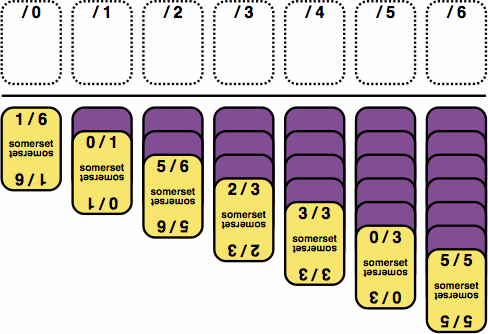 |
|---|
Above the line are the foundations, originally empty, one associated with suit. Below the line are the piles. Although the number of piles happens to equal the number of suits, there is no association between any pile and any suit.
The first pile has one card, the second pile two, et cetera. The top card of each pile is dealt face up, all others face down. As the game progresses, if the top card of a pile is moved away and the top remaining card is face down, it is turned face up. Sometimes a pile will be empty.
The goal is to promote all 28 cards to the foundations; this is done one card at a time by moving a card from a pile to a foundation. Only the top card of a pile is eligible for promotion, but when moved away it might uncover another card that itself can be promoted. The first card that can be played to a foundation is of rank zero. After that follow cards of rank one, rank two, et cetera, as they become available. The player is not required to promote a card at the earliest opportunity, and sometimes it is a good idea to wait.
In a winning game, the /0 foundation will contain one card, the /1 foundation two cards, the /2 foundation three cards, et cetera; and all piles will be empty.
The list of moves from a complete game follows, including in its description the rules for moving a card from one pile to another. The details will be unsurprising to anyone familiar with Klondike.
⇒ Promote 0/1, revealing 0/4.
⇒ Promote 0/3, revealing 6/6.
⇒ Move 2/3 to 3/3, revealing 4/4.
⇒ Move 5/5 to 5/6, revealing 0/5.
| stage 2 | 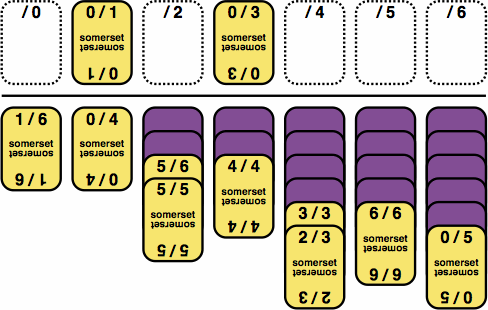 |
|---|
The top card of one pile can be placed on top of another pile under either of two circumstances:
⇒ Promote 0/4, leaving an empty pile.
⇒ Promote 0/5, revealing 2/5.
⇒ Move 5/5-5/6 to 6/6, revealing 3/5.
| stage 3 | 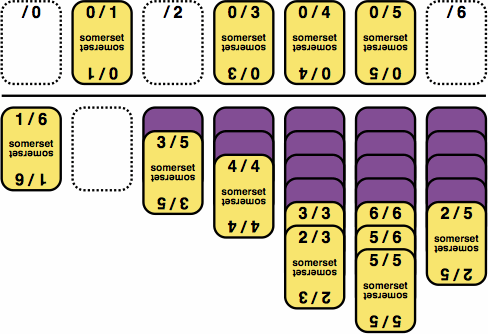
|
|---|
Two or more face-up cards at the top of one pile may be moved to the top of another pile, if the bottom card of those being moved satisfies the junction rule with the top card of the destination.
⇒ Move 2/5 to 3/5, revealing 2/6.
⇒ Move 5/5-5/6-6/6 to an empty pile, revealing 0/0.
| stage 4 | 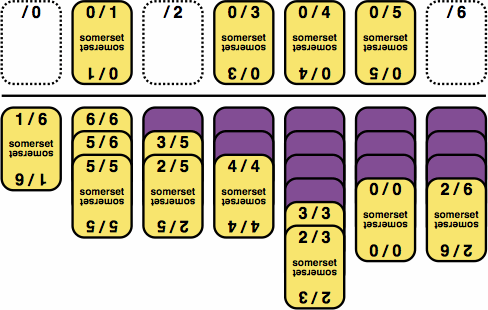 |
|---|
Face-up card(s) at the top of one pile may be moved to an empty pile, if the bottom card of those being moved is a double.
Incidentally, the tableau can be represented using an HTML table instead of an image, reducing bandwidth. However, this method might be less instructive to the Somerset Klondike novice:
| stage 4 | / 0 | 0 / 1 | / 2 | 0 / 3 | 0 / 4 | 0 / 5 | / 6 |
|---|---|---|---|---|---|---|---|
| 1 / 6 | 6 / 6 | ||||||
| 5 / 6 | 3 / 5 | ||||||
| 5 / 5 | 2 / 5 | 4 / 4 | |||||
| 0 / 0 | 2 / 6 | ||||||
| 3 / 3 | |||||||
| 2 / 3 | |||||||
⇒ Promote 0/0, revealing 1/3.
⇒ Move 1/6 to 2/6, leaving an empty pile.
⇒ Move 5/5 to the empty pile where 1/6 had been.
| stage 5 | 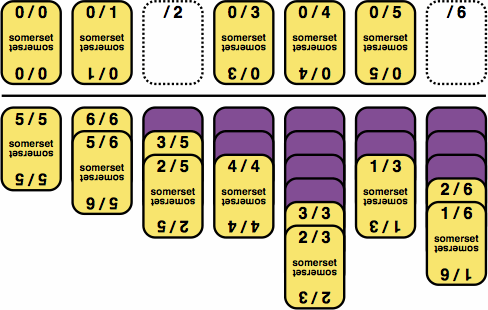 |
|---|
In moving the 5/5, note it is legal to move only a portion of the face-up cards in a pile, as long as those being moved are on top.
⇒ Move 1/3 to 2/3, revealing 4/5.
| stage 6 | 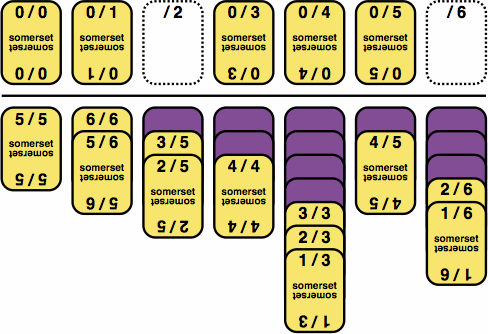 |
|---|
⇒ Promote 1/3, revealing 2/3.
⇒ Move 4/4 to 4/5, revealing 2/4.
⇒ Move 4/4-4/5 to 5/5, revealing 1/2.
| stage 7 | 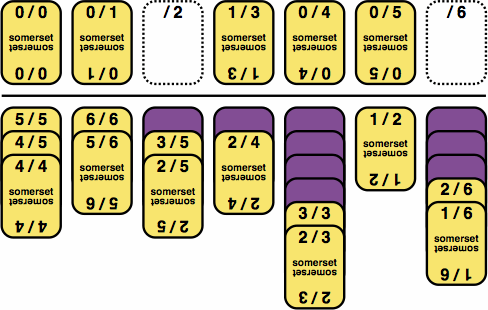 |
|---|
⇒ Move 4/4-4/5-5/5 to 5/6, leaving an empty pile.
⇒ Move 2/3-3/3 to the empty pile where 5/5 had been, revealing 0/2.
| stage 8 | 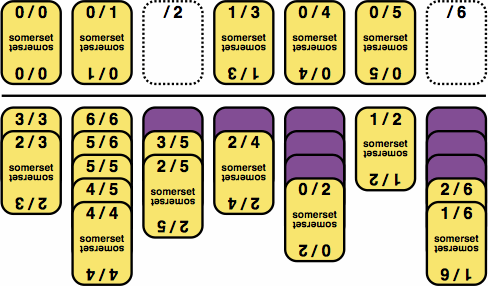 |
|---|
⇒ Promote 0/2, revealing 3/4.
⇒ Promote 1/2, leaving an empty pile.
⇒ Move 4/4 to the empty pile where 1/2 had been, revealing 4/5.
⇒ Move 2/5-3/5 to 4/5, revealing 1/1.
| stage 9 | 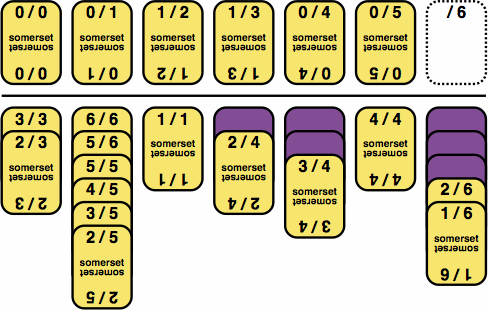 |
|---|
⇒ Promote 1/1, leaving an empty pile.
⇒ Move 3/4 to 4/4, revealing 3/6.
⇒ Move 2/4 to 3/4, revealing 0/6.
| stage 10 | 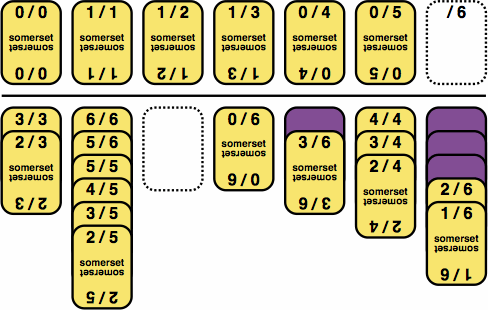 |
|---|
⇒ Promote 0/6, leaving an empty pile.
⇒ Promote 1/6 and 2/6, revealing 2/2.
⇒ Promote 3/6, revealing 4/6.
| stage 11 | 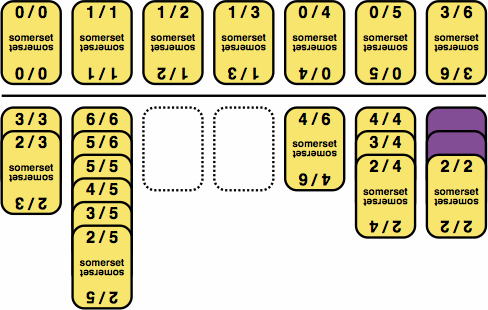 |
|---|
⇒ Promote 2/2, revealing 1/5.
⇒ Promote 2/3, 3/3, and 4/6, leaving empty piles.
| stage 12 | 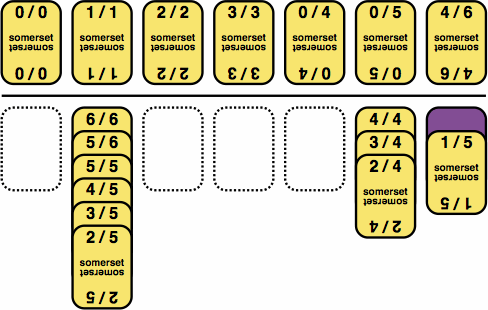 |
|---|
⇒ Promote 1/5, revealing 1/4.
| stage 13 | 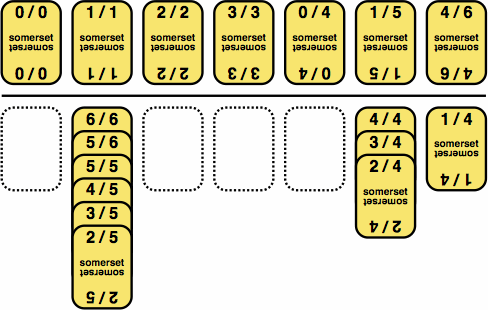 |
|---|
Now that all the cards in the piles are face up, they are easily promoted, yielding the winning configuration:
| stage 14 | 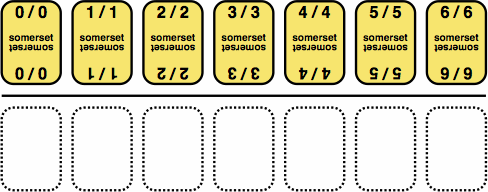 |
|---|
If the game is played with nine ranks extracted from a Triple Somerset pack, the tableau will start out like this:
| nine ranks | 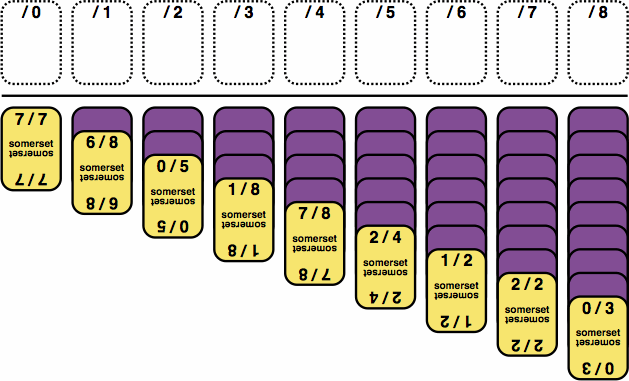 |
|---|